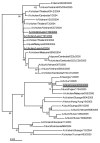H5N1 influenza viruses in Lao People's Democratic Republic
- PMID: 17176581
- PMCID: PMC3290961
- DOI: 10.3201/eid1210.060658
H5N1 influenza viruses in Lao People's Democratic Republic
Abstract
A prospective surveillance program for influenza viruses was established in Lao People's Democratic Republic (PDR) in July of 2005. We report isolation of H5N1 virus genetically distinct from H5N1 circulating in 2004, which indicates reintroduction of H5N1 into Lao PDR after its disappearance (i.e., no virologic or serologic evidence) for 2 years.
Figures


References
-
- Tang X, Tian G, Zhao J, Zhou KY. Isolation and characterization of prevalent strains of avian influenza viruses in China [article in Chinese]. Chinese Journal of Animal and Poultry Infectious Diseases. 1998;20:1–5.
-
- Cauthen AN, Swayne DE, Schultz-Cherry S, Perdue ML, Suarez DL. Continued circulation in China of highly pathogenic avian influenza viruses encoding the hemagglutinin gene associated with the 1997 H5N1 outbreak in poultry and humans. J Virol. 2000;74:6592–9. 10.1128/JVI.74.14.6592-6599.2000 - DOI - PMC - PubMed
Publication types
MeSH terms
Grants and funding
LinkOut - more resources
Full Text Sources
Other Literature Sources
Medical
